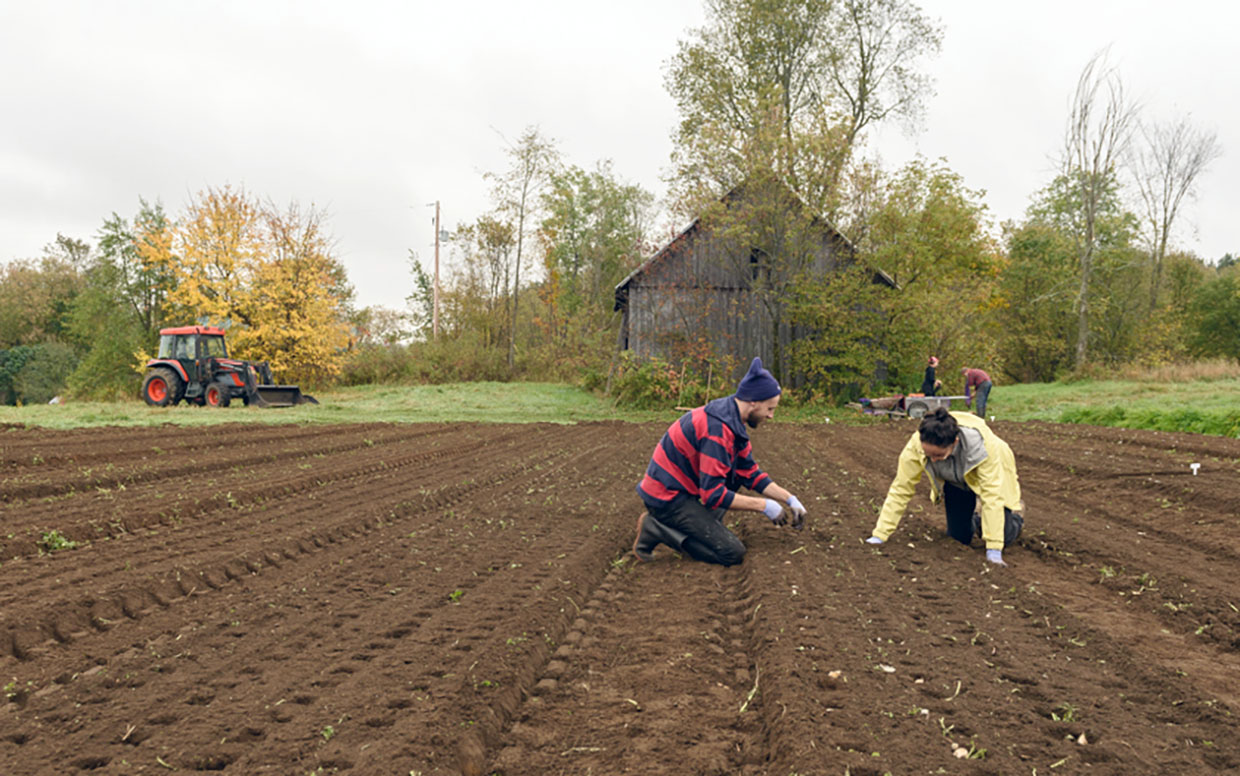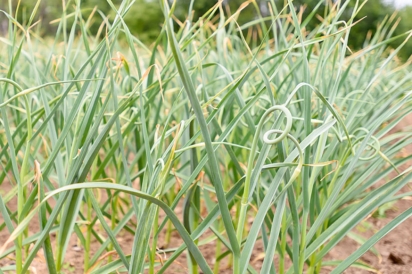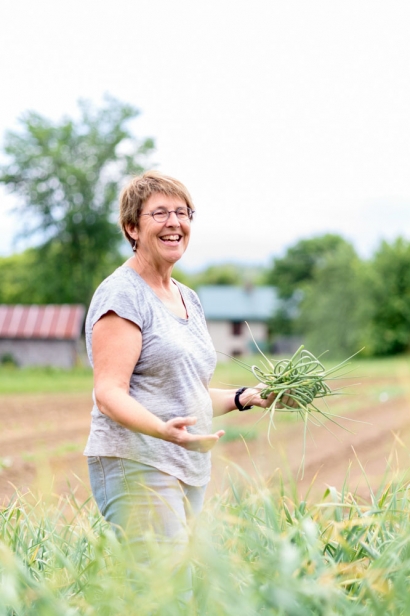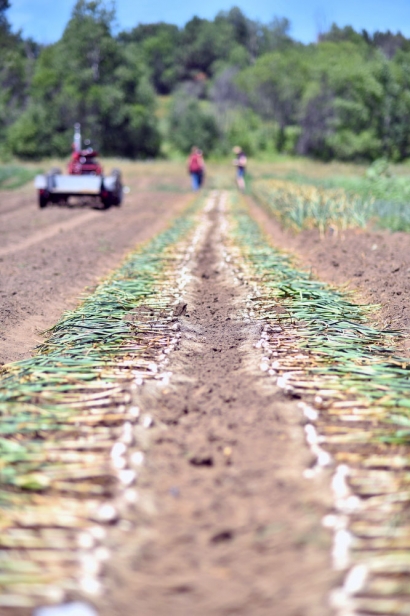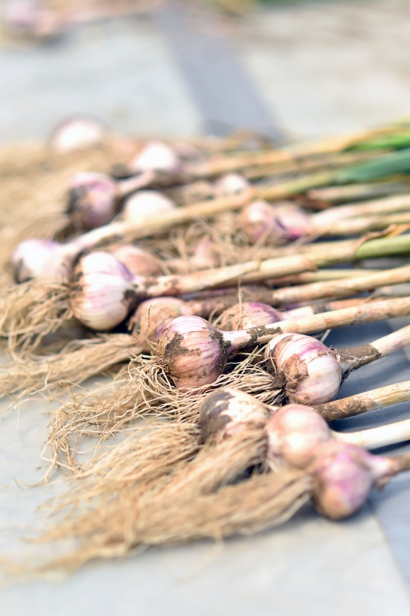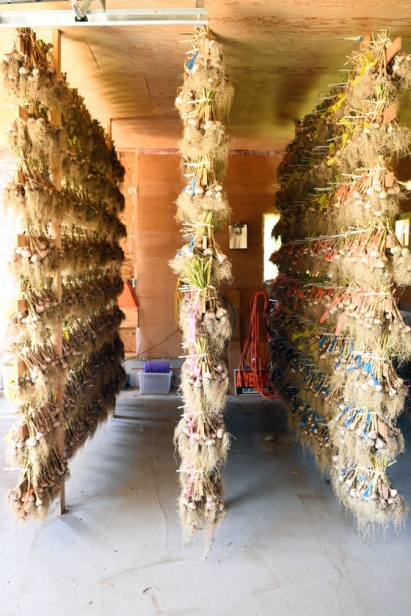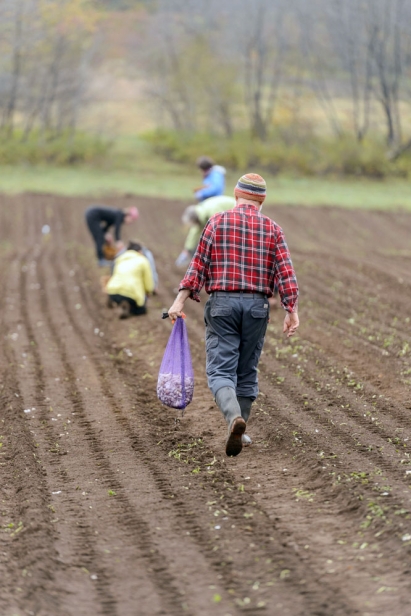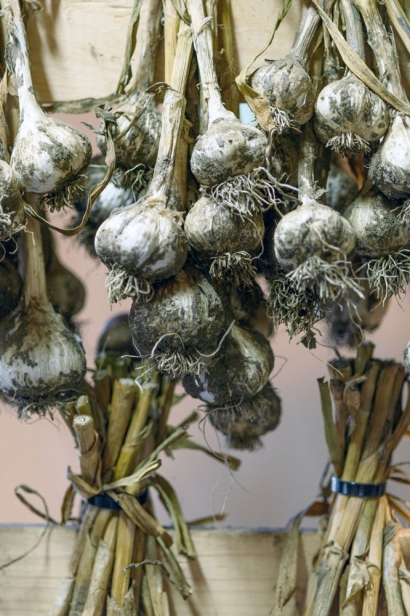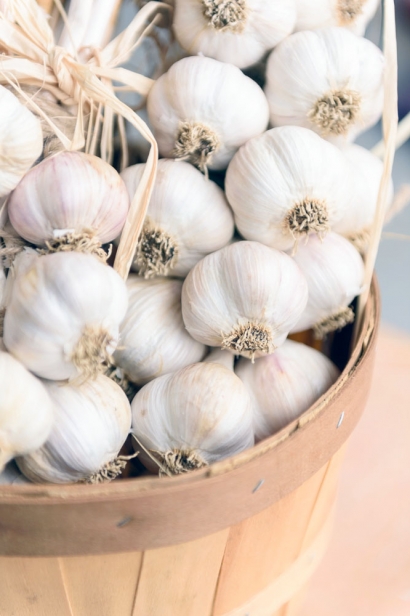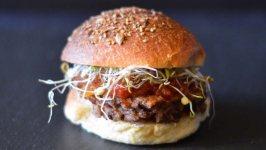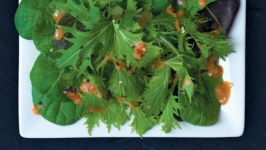Finding Room to Grow
Every July, Gary Bougard and Renée Giroux get on the phone and call in favours from their friends and family — knowing they only have a small window to harvest their large garlic crop.
“Around the 15th of July — give or take a week — is harvest,” Bougard says. “There’s only about a four- or five-day window where it’s just perfect; so you sweat and you call up all your friends.
“Our friends don’t return our phone calls at that time,” he jokes wryly. Laughter immediately breaks out around the table where I’m sitting with the farming couple and photographer Amy Zambonin, sipping homemade rhubarb lemonade. It’s an overcast but pleasant day in June and a slight breeze moves the wind chimes outside of the tranquil, screened-in porch where we’re discussing all things garlic.
The art form, explains Bougard, is knowing exactly when the garlic is ready for harvest.
“You’ve got to get it all out of the ground within about a week or it starts to lose its outside wrappers and then it doesn’t store as well,” he says. “You pull it out of the ground, you cut off cross sections to see how well it’s developing, you count the number of wrappers, you count the number of dead leaves on top… and if about half of them are dead on top then you’re probably running a little late.”
The couple’s relaxed confidence stems from their years of experience, but they’re quick to admit they weren’t always so intuitive about the garlic harvest.
“We made all the mistakes — including pulling out garlic way too late — so when we’d pull it out it would be like a stick with no wrappers around it,” Giroux says. “That’s why we’ve learned.”
As we stroll through the rows of garlic on this June day, the greens reach up to nearly waist level from the garlic bulbs, which are still hiding beneath the soil. In the centre of each plant is a substantial green stem that gently twists in a downward loop; Giroux explains that this indicates the garlic is nearly ready for harvesting. She moves swiftly along the row, expertly snapping off this centre loop — called the scape. With a consistency similar to asparagus, but with a mild, garlicky flavour, scapes can be steamed and enjoyed as a healthy, green side dish; they are also great in pestos, soups, and salads. The farm sells them to a number of restaurants, including Edgar, Soif Bar à vin and Four Sisters Foods (a caterer who sells prepared foods at the Ottawa Farmers’ Market).
Mayo Hill Garlic sells at the Ottawa Farmers’ Market in Byron Park (Westboro) — where the team sells garlic from the last weekend of August until it closes at the end of October. Bougard and Giroux also sell at the Christmas market at Lansdowne Park.
“At the market, there are the gourmets who like good food and there’s also a lot of people who buy it for medicinal purposes — they cut it up,” Giroux says. “Mostly, it’s people who like good food; garlic lovers are fun to talk to.”
While the bulk of the business is in consumer sales, Giroux adds they also sell seed garlic to growers. With customers from the Maritimes to British Columbia, this is a part of the business Giroux would like to expand.
Bougard and Giroux started garlic farming eight years ago, inspired while staying at a bed and breakfast that had a garlic operation in Manitoulin Island, a Canadian island in Lake Huron.
“We had been organic farmers and were getting absolutely nowhere and we’d given that up about five or six years earlier,” Bougard says. “We kept looking at this garlic and thinking, ‘Now this is interesting.’ So we bought some there and away we went.”
After the “organizational nightmare” of multiple vegetable crops, focusing on a single crop was very appealing, Giroux adds.
“The complexity is that we have more than 20 varieties — so it’s keeping everything sorted out — but the season is the same for every garlic,” she says. “That was appealing to us; instead of being spread thin all over the place and competing with everyone doing the same thing.”
The organic garlic industry, it seems, offers plenty of room to grow. “Canada only produces 10 per cent of the garlic that’s consumed [here]; a lot of it is imported from China, the U.S., Spain and Argentina,” says Giroux, who sees Canada’s changing demographics driving an increased demand for garlic.
“My grandfather was a vegetable market gardener near Quebec City; he never grew garlic,” she recalls. “We never had garlic in our food when I was growing up — it just wasn’t something that was used.
“The change in demographics — the multiculturalism — with so many people coming from Europe and all over the place, garlic has now become a staple.”
Like most food products, you get what you pay for — and that’s certainly true of Mayo Hill Garlic. “We’re expensive compared to what’s imported from Argentina and Spain — and definitely more expensive than China,” Bougard says. He sees a growing trend of consumers moving away from Chinese garlic in particular.
“It’s very burning and the amount of chemicals being used is pretty phenomenal; they’re using a lot of chemical fertilizers, insecticides, herbicides, the list goes on,” he says.
In contrast, Mayo Hill Garlic is certified organic. As Bougard explains, the crop is on a four-year growing cycle. “The year after the garlic moves on, the area is a vegetable patch,” he says. “Then we have 2.5 years of cover crops — we’ll grow rye, buckwheat, oats, mustard — and we plow it under; so every year the soil is getting better and better and better.”
The area has a very light soil — without much clay — so the four-year cycle builds organic matter.
“We’re building nutrients for over two years before the garlic hits again,” Bougard says. By the time the garlic comes around it’s following two years of cover crops so the nutrient level is really high — I don’t have to use fertilizers.”
He adds that they do have access to horse manure, but it’s getting expensive to transport it. “It’s $120 — $130 for a truckload and there’s a lot of truckloads.”
Another big differentiator between organic and store-bought garlic is the shelf life. Those little green shoots — which sprout up within two weeks of purchasing imported, grocery store garlic — are the result of the product being stored in refrigeration units.
“Sprouting range is around plus two, three, four degrees,” Bougard explains. “So when you bring it from cold through that range, it’s ready to sprout… plus it’s probably six months old.”
Mayo Hill Garlic, on the other hand, offers a guarantee that their garlic is good until the end of February — no matter when you buy it. That’s because it’s cured after harvesting — a process that takes from three to four weeks.
“After we have harvested the garlic, we prepare it for the curing process,” Giroux says. “It’s trimmed and tied in bunches; then it’s hung on racks in our drying shed or put on horizontal racks in the greenhouse.”
Giroux adds there are large fans and heaters running continuously, to help with the drying process. “Once the garlic is ready, the bulbs are cleaned and sorted — into our seed, seed for sale and eating garlic for sale. Then, it’s put into bags or braids for market.”
Soon, Bougard and Giroux will turn their focus to planting, which takes place in mid-October. As with the harvest, planting must be done within a small window, weather permitting, for optimal results.
“We don’t want to plant too early or it will sprout before the snow hits,” Bougard says. “You have to break the bulbs open because you plant the cloves, and that’s a lot of work — and you want to get it within four or five days of when you’re actually planting.” Once again, family and friends contribute to the critical mass of bodies. In exchange for their efforts, Bougard and Giroux ensure there’s a festive atmosphere on the farm.
“What we do every year is we buy several bottles of wine and make a huge supper of some sort and invite everybody over,” Bougard says. “Then when supper’s over, we go out to the garage and all sit around tables — usually around 12 people — and crack garlic and talk.”
The next day, the couple’s kids and their friends come to help. “Some crack and some plant and usually in two days we’re done planting,” Giroux says. “It’s kind of a fun thing because it’s a day out in the country; it’s a nice time of year because we’re also harvesting all sorts of other stuff.
Mayo Hill Garlic
3790 Rte. 315, Mayo, Que.
mayohillgarlic.com | 819.281.1496


